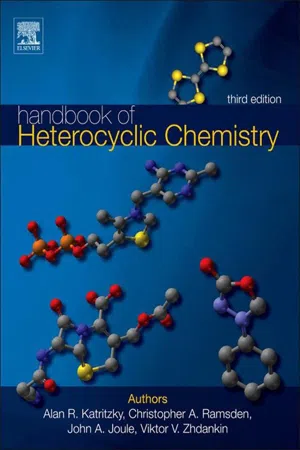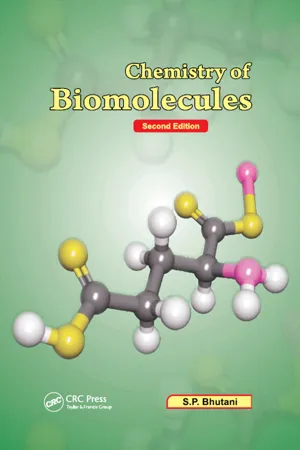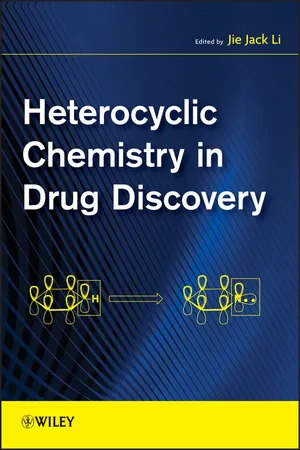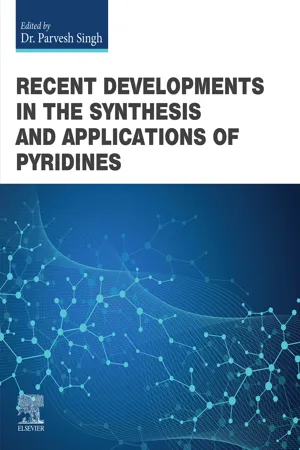Chemistry
Pyrimidine
Pyrimidine is a heterocyclic aromatic organic compound composed of a six-membered ring with four carbon atoms and two nitrogen atoms. It is a fundamental component of nucleic acids such as DNA and RNA, where it pairs with purines to form the building blocks of genetic material. Pyrimidine derivatives are also important in pharmaceuticals and agrochemicals.
Written by Perlego with AI-assistance
7 Key excerpts on "Pyrimidine"
- eBook - ePub
Chemistry for Pharmacy Students
General, Organic and Natural Product Chemistry
- Lutfun Nahar, Professor Satyajit D. Sarker(Authors)
- 2019(Publication Date)
- Wiley(Publisher)
Like 1,3‐azoles, due to the presence of a pyridine‐like nitrogen atom in the ring, 1,2‐azoles are also much less reactive towards electrophilic substitutions than furan, pyrrole or thiophene. However, 1,2‐azoles undergo electrophilic substitutions under appropriate reaction conditions and the main substitution takes place at the C‐4 position; for example, bromination of 1,2‐azoles. Nitration and sulphonation of 1,2‐azoles can also be carried out, but only under vigorous reaction conditions.6.6 Pyrimidine
Pyrimidine is a six‐membered aromatic heterocyclic compound that contains two nitrogen atoms, separated by a carbon atom, in the ring. Nucleic acids, DNA and RNA, contain substituted purines and Pyrimidines. Cytosine, uracil, thymine and alloxan are just a few of the biologically significant modified Pyrimidine compounds, the first three being the components of the nucleic acids.A number of drug molecules contain modified Pyrimidine skeleton, the best‐known examples being the anticancer drug, 5‐fluorouracil, which is structurally similar to thymine, the antiviral drug, AZT, currently being used in the treatment of AIDS and phenobarbital, a well‐known sedative.Two positional isomers of Pyrimidine are pyridiazine and pyrazine, which only differ structurally from of Pyrimidine in terms of the position of the nitrogen atoms in the ring. These three heterocycles together with their derivatives are known as diazines.6.6.1 Physical Properties of Pyrimidine
Pyrimidine is a weaker base than pyridine because of the presence of the second nitrogen. Its conjugate acid is a much stronger acid (pK a = 1.0). The pK a values of the N‐1 hydrogen in uracil, thymine and cytosine are 9.5, 9.8 and 12.1, respectively. Pyrimidine is a hygroscopic solid (bp: 123–124 °C, mp: 20–22 °C) and soluble in water.6.6.2 Preparations of Pyrimidine
The combination of bis‐electrophilic and bis - eBook - ePub
New Frontiers in Nanochemistry: Concepts, Theories, and Trends
Volume 1: Structural Nanochemistry
- Mihai V. Putz(Author)
- 2020(Publication Date)
- Apple Academic Press(Publisher)
CHAPTER 41Pyrimidines
NICOLETA A. DUDAŞ and MIHAI V. PUTZ
Laboratory of Computational and Structural Physical Chemistry for Nanosciences and QSAR, Biology-Chemistry Department, West University of Timişoara, Pestalozzi Str. No. 16, Timişoara 300115, Romania, E-mails: [email protected] , [email protected] , [email protected]41.1 DEFINITION
Pyrimidines (1,3-diazines or m-diazines) are one of three classes of six-membered heterocyclic aromatic compounds containing two nitrogen atoms in their ring, the other two diazines being pyridazines (1,2-diazines) and pyrazines (1,4-diazines). The Pyrimidine ring is the basic structural element of nitrogenous bases of DNA and RNA, is one of the most widespread heterocyclic in various biologically important derivatives, as substituted derivatives and ring-fused compounds.Pyrimidine derivatives are utilized as drugs in the treatment of several types of diseases, agrochemicals, chromophores, complexes, metal sensors, solar cells technology, etc. Pyrimidines can be obtained by the synthetic chemical route, from biosynthesis (metabolism ↔ catabolism) and also in prebiotic condition.Because the Pyrimidine ring contains two nitrogen atoms it has a weakly basic character, Pyrimidine systems are highly electron deficient, and that is why electrophilic aromatic substitution gets more difficult, while nucleophilic aromatic substitution gets easier.41.2 HISTORICAL ORIGIN(S)
The first pyrimidinic compounds that were discovered are alloxan – 1818, guanine – 1844, barbituric acid – 1864, cytosine – 1894, uracil – 1900, and in 1899 was first synthesized unsubstituted Pyrimidine (Figure 41.1 ) (Brown et al., 1994; Harris & Thimann, 1949; Grimaux, 1879; Fischer, 1897; Kossel & Steudel, 1903; Gabriel & Colman, 1899; Baeyer, 1864). The first simple Pyrimidine derivatives that have been extracted from natural sources are vicine and convicine in 1870 from Vicia sativa and Vicia faba L - eBook - ePub
Palladium in Heterocyclic Chemistry
A Guide for the Synthetic Chemist
- Jie Jack Li, Gordon Gribble(Authors)
- 2006(Publication Date)
- Elsevier Science(Publisher)
Chapter 11Pyrimidines
Michael PaluckiThe Pyrimidine entity is one of the most prominent structures found in nucleic acid chemistry. Pyrimidine derivatives including uracil, thymine, cytosine, adenine, and guanine are fundamental building blocks for deoxyribonucleic acid (DNA) and ribonucleic acid (RNA). Vitamin B1 (thiamine) is a well-known example of a naturally occurring Pyrimidine that is encountered in our daily lives. Synthetic Pyrimidine-containing compounds also occupy a prominent place in the pharmaceutical arena. Pyrimethamine and Trimethoprim are two representative Pyrimidine-containing chemotherapeutics. Pyrimethamine is a dihydrofolate reductase inhibitor; effective for toxoplasmosis in combination with a sulfonamide; whereas Trimethoprim is an antimalarial drug, widely used as a general systemic antibacterial agent in combination with sulfamethoxazole.Due to the electronegativity of the two nitrogen atoms, the Pyrimidine ring is a deactivated, π-electron-deficient heterocycle. Its chemical behavior is comparable to that of 1,3-dinitrobenzene or 3-nitropyridine. One or more electron-donating substituents on the Pyrimidine ring are often required for effecting electrophilic substitution reactions. In contrast, nucleophilic displacement is significantly more facile on a Pyrimidine ring compared to a pyridine ring. This trend also extends to palladium chemistry: Pd(0) undergoes oxidative addition more readily with 4-chloroPyrimidine than with 2-chloropyridine.Remarkable differences in the inherent reactivity for each C-position on pyrimidinyl halides and triflates have been observed. The C(4) and C(6) positions of a haloPyrimidine are more prone to SN Ar processes than the C(2) position. The order of SN Ar displacement for haloPyrimidines is:This trend is also observed in palladium chemistry where the general order for oxidative addition often correlates with that of nucleophilic substitution. Not only are 2-, 4-, and 6-chloroPyrimidines viable substrates for palladium-catalyzed reactions, but 4- and 6-chloroPyrimidines react more readily than 2-chloroPyrimidines. - eBook - ePub
- S. P. Bhutani(Author)
- 2019(Publication Date)
- CRC Press(Publisher)
The function and structure of a number of enzymes possessing the Pyrimidine ring have been established. Purines can also be strictly considered as Pyrimidine derivatives. Deoxyribonucleic acid contains adenine and guanine.B. Aromatic Character of Pyrimidine
All the parent diazine ring systems may be regarded as aromatic. This conclusion has been derived from the experimental observations of the C—C and C—N bond lengths which have been found to be intermediate in length between the values expected for the characteristic single and double bond in question.In case of simple Pyrimidine, the dimensions have not be determined yet, although a number of derivatives have been studied in this connection. An example is 4-amino-2,6-dichloroPyrimidine. The bond distances are given in its structure below. Out of the two C—C bond distances (1.40 Å and 1.35 Å) one is very close to the C—C distance of benzene (1.39 Å).The general similarity of the size and shape of the Pyrimidine ring to that of benzene and pyridine is consistent with its highly aromatic chemical characteristics. Thus, Pyrimidine also undergoes the usual electrophilic substitution reactions.The differences between the bond angles and bond distances between the ring systems suggest that there is maximum distortion in the case of Pyrimidine. This is in agreement with the resonance energies calculated by molecular orbital methods. The values are benzene 36 K cal, pyridine = 31 K cal and Pyrimidine = 26 K cal/mole.Pyrimidine is best considered as a resonance hybrid of eight structures, out of which only two are uncharged structures. The p-electron densities at the 2, 4 and 5-positions have been calculated as 0.776, 0.825 and 1.103 respectively.C. Chemical Properties of Pyrimidine
An enormous amount of work has been done on the derivatives of Pyrimidines but the chemical reactions of Pyrimidine itself have been investigated only recently. This is partly because Pyrimidine was not readily available. However, it can now be obtained quite easily. - eBook - ePub
- Jie Jack Li(Author)
- 2013(Publication Date)
- Wiley(Publisher)
118, 10672–10673.65. Zhou, Q.; Zheng, Y.-Y.; Li, B.-D.; Lu, C.-X. Jiangsu Huagong 2005, 33, 124–126.66. Nasielski, J.; Heilporn, S.; Nasielski-Hinkens, R. Tetrahedron 1989, 45, 7795–7804.67. Torr, J. E.; Large, J. M.; Horton, P. N.; Hursthouse, M. B.; McDonald, E. Tetrahedron Lett. 2006, 47, 31–34.68. (a) Li, J. J.; Yue, W. S. Tetrahedron Lett. 1999, 40, 4507–4510. (b) Iwata, S.; Sakajyo, M.; Tanaka, K. J. Heterocyclic Chem. 1994, 31, 1433–1438.Passage contains an image
Chapter 13
Pyrimidines
Sha Lou and Ji Zhang13.1 Introduction
Pyrimidine is a six-membered heterocyclic ring with a structure similar to benzene except that two C–H units are replaced with nitrogen atoms. As a result, its bond lengths and bond angles differ from benzene as shown below. For example, the benzene ring bond length is 1.40 A with a bond angle of 120 °. The Pyrimidine ring is virtually flat, however, the electron distribution is no longer distributed equally at each atom. There is considerable depletion of electron density at the 2-, 4-, and 6-positions; a moderate depletion at the 5-position, and significantly increased electron density at the nitrogen atoms. Pyrimidine is a much weaker base (pKa 1.31) than pyridine (pKa 5.2) because the second ring-nitrogen shares the available π-electrons with the first nitrogen. The dipole moment of Pyrimidine is measured to be in the range of 2.10 to 2.40 D. Proton NMR and 13 C NMR are shown below.A large number of natural products and pharmaceuticals possess the Pyrimidine structure. For example, sulfadiazine is a sulfonamide antibiotic that contains a 5-aminoPyrimidine.1 - Parvesh Singh(Author)
- 2022(Publication Date)
- Elsevier(Publisher)
Its cyclic nature was recognized by Dewar and Korner in 1869 [8]. Pyridine and its related derivatives are a privileged class of heterocyclic compounds found in various chemotherapeutic agents [ 9, 10 ]. Pyridine is widely found in many natural products such as vitamins, alkaloids and coenzymes and forms the nucleus of around 253 FDA-approved drugs. Pyridine-based compounds are known to possess a remarkable biological and pharmacological activity including antimicrobial [11], antimalarial [12], anticancer [13], HIV inhibitors [14], antioxidant [15], and many others [16]. Pyridine moieties are frequently used in drugs due to their characteristics such as stability, water solubility, basicity, hydrogen bond-forming capacity, and small molecular size, which help to improve pharmacokinetic, pharmacological, and physicochemical properties. The effective therapeutic behavior of pyridines in drug discovery is mainly based on their mimicking nature. Pyridine ring acts as bioisostere of benzene, amines, amides, and other nitrogen-containing heterocycles. Pyridine is aromatic and possesses six delocalized electrons in the ring (Fig. 12.1). The nitrogen's lone electron pair of pyridine occupies sp 2 orbital parallel to the ring plane. Therefore, this electron pair does not participate in the aromatic π-system ring and more available for donation. In comparison to benzene, pyridine is an electron deficient and polar molecule due to the electron-withdrawing effect of the highly electronegative nitrogen atom. The electron density in pyridine ring at the C-2, C-4, and C-6 positions is less than that at the C-3 and C-5 positions. Therefore, pyridine has a dipole moment and a weaker resonant stabilization than benzene- Rajesh Kumar Singh(Author)
- 2002(Publication Date)
- Bentham Science Publishers(Publisher)
The base pair of RNA and DNA like adenine, guanine, thymine, and cytosine are also made up of N -heterocyclic compounds i.e., purine and Pyrimidine nucleus. Their vast biological properties are due to the N atom's electron-rich nature present in moiety, which can easily form various interactions like H- bonding, Vander wall, dipole-dipole interaction, etc. with target molecule [ 9 - 12 ]. A quick search of FDA databases demonstrates the structural importance of nitrogen-based heterocycles in pharmaceutical drug design and engineering, with nitrogen heterocycles accounting for over 60% of all small-molecule medications [ 13 ]. With the advancement of the N -heterocyclic compound, researchers now shifted their interest towards the other heterocyclic rings. Thus, they synthesized S -based heterocyclic compounds. These compounds show their significant role in anticancer activity due to the high reactivity of sulfur atoms in the molecule. These heterocyclic compounds can bind suitably to pharmacological targets and receptors via intermolecular H-bonds more effectively, giving desired pharmacological effects. They can also alter liposolubility, hence the aqueous solubility of drug molecules to achieve remarkable pharmacokinetic properties. Given the relevance of sulphur in biological systems and its growing popularity as a regulatory agent, the rationale for using sulfur-based heterocycle medicines becomes vibrant. These N and S -based heterocyclic compounds are used in rational drug design for anticancer drugs with favorable therapeutic index [ 14, 15 ]
Index pages curate the most relevant extracts from our library of academic textbooks. They’ve been created using an in-house natural language model (NLM), each adding context and meaning to key research topics.
Explore more topic indexes
Explore more topic indexes
1 of 6
Explore more topic indexes
1 of 4






